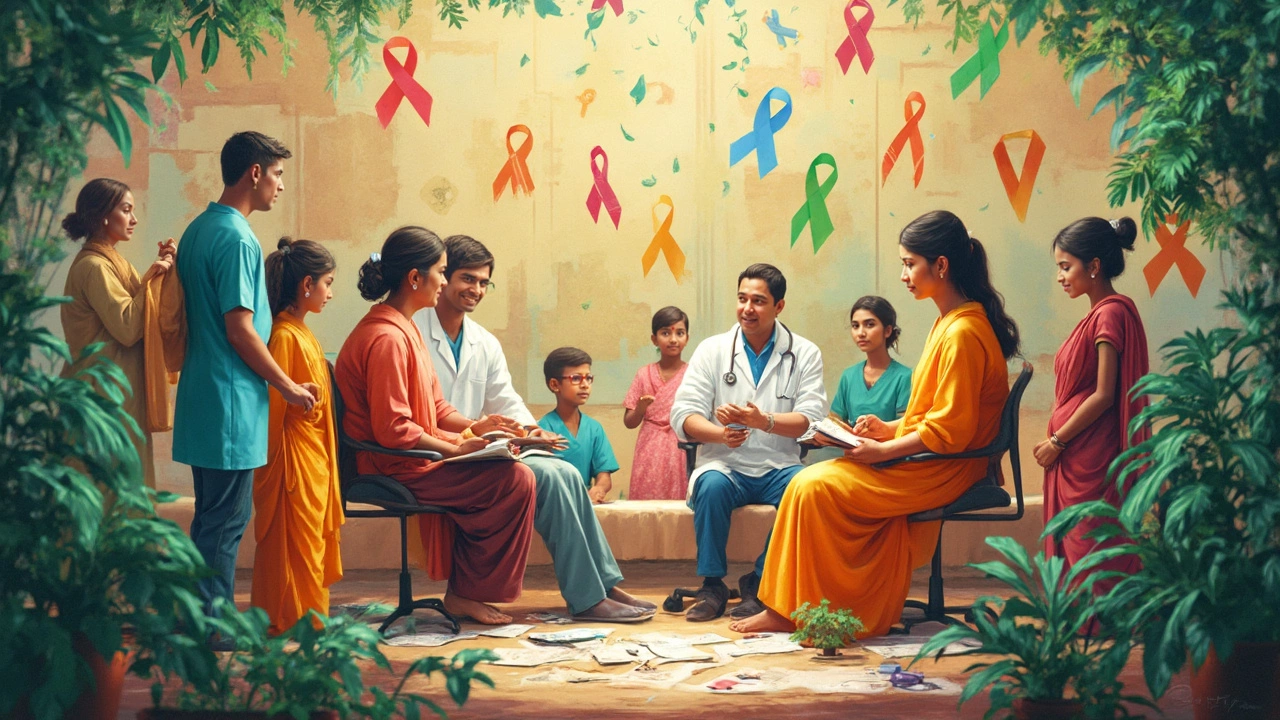
- Feb, 15 2025
- 0
Cancer diagnosis is one of the toughest things a person can face, but here's a glimmer of hope: not all cancers are created equal when it comes to survival rates. Some types have better outcomes, and understanding which these are can provide much-needed assurance. Let's talk about three of the most survivable cancers today.
Firstly, catching cancer early can significantly shift the odds in your favor. Regular check-ups, routine screenings, and being mindful of your body are key in spotting issues before they become serious. With advances in medical technology, many cancers are now more detectable than ever.
Thyroid cancer often tops the list of survivable cancers. Known for its higher survival rates, especially in women, thyroid cancer has benefited greatly from advancements in treatment methods. Most cases are caught early, and treatments have been refined over the years, resulting in excellent recovery rates.
- Understanding Cancer Survivability
- The Role of Early Detection
- Thyroid Cancer: A Beacon of Hope
- The Battle with Prostate Cancer
- Breast Cancer: Progress and Hope
Understanding Cancer Survivability
When talking about cancer, survival rates can be a game-changer. They give us a glimpse of hope and the potential outcomes post-diagnosis. But what exactly do we mean by survivability?
At its core, cancer survivability refers to the likelihood that someone will continue to live after being diagnosed with cancer for a certain period. Typically, this is measured in five-year survival rates, which show the percentage of people who are alive five years after their cancer diagnosis. It's important to note that these rates can vary dramatically between different types of cancer.
The Importance of Early Detection
The role of early detection can't be overstated when it comes to boosting survival rates. Spotting cancer in its initial stages often leads to more successful treatment outcomes. Regular screenings for certain cancers, like mammograms for breast cancer or PSA tests for prostate cancer, are crucial in catching the disease before it spreads.
A big benefit of early detection is that it often allows for less invasive treatments. If you catch cancer early, the treatment may be less aggressive, leading to fewer side effects and a better quality of life.
Treatment Advancements
Medical advancements have played a significant role in improving cancer treatment. New therapies, targeted drugs, and less invasive surgical techniques have revolutionized how we approach cancer care. For cancers like thyroid and prostate, these advancements have resulted in remarkable recovery rates.
| Cancer Type | Five-Year Survival Rate |
|---|---|
| Thyroid Cancer | 98% |
| Prostate Cancer | 97% |
| Breast Cancer | 90% |
These statistics show promising survival outcomes, stressing the effectiveness of modern medical practices and patient awareness in managing these diseases.
In a nutshell, understanding cancer survivability is not just about statistics; it’s about knowing your body, utilizing advancements in medicine, and taking every step to catch it early.
The Role of Early Detection
Early detection is a game-changer when it comes to battling cancer. Spotting cancer early can seriously up your chances of effective treatment and survival. It might even be your best defense, giving you a better shot at recovery.
Why focus so much on early detection? Simply, it can make all the difference between a cancer that's treatable and one that's not. Many cancers, such as breast cancer and prostate cancer, often display no symptoms in the initial stages. That's why screening tests and regular check-ups are crucial. They catch abnormalities before they become a full-blown problem.
"Cancer is a word, not a sentence. Early detection is key in changing the narrative." - John Diamond, Journalist.
Currently, lots of effective screening methods exist for various cancers. Thyroid cancer, for example, can be detected through simple physical examination and ultrasound screenings. These methods have significantly contributed to its high survival rates.
The Importance of Regular Screenings
Routine screenings can help find cancer before symptoms appear. For example, mammograms for breast cancer and PSA tests for prostate cancer have saved countless lives by catching cancer early.
- Regular mammograms can decrease the risk of dying from breast cancer by 25-30% for women over 50.
- PSA tests can potentially identify prostate cancer early when it's most treatable.
Understanding your risk factors also plays a big role. Knowing your family history or genetic predisposition can guide you and your doctor in creating a personalized screening plan.
Technology and Research
Let's not forget about the role of technology and research. Advances in medical imaging and genomic studies are helping doctors identify cancers earlier and with greater accuracy. As technology improves, so do the methods for early cancer detection, which translates into more survivable outcomes for patients.
In essence, early detection empowers you with choices and a fighting chance. So, make those doctor's visits, get screened when recommended, and stay proactive about your health.
Thyroid Cancer: A Beacon of Hope
When it comes to survivable cancers, thyroid cancer often stands out as a beacon of hope. Despite being a daunting diagnosis, this type of cancer boasts one of the best survival rates. Let's break down why thyroid cancer maintains this optimistic reputation.
The thyroid is a small gland located at the base of your neck, playing a key role in regulating metabolism through hormone production. While the cancer itself can sound pretty scary, most cases are highly treatable.
Why the High Survival Rate?
The main reason thyroid cancer has such a high survival rate is due to early detection and effective treatments. It's often detected early, sometimes even before symptoms appear, thanks to routine neck and physical exams. This early detection is crucial as it allows for timely intervention.
Another factor is the nature of the cancer itself. Many thyroid cancers, such as papillary and follicular types, grow slowly and are less aggressive than other cancers. This makes them more manageable with treatments like surgery and radioactive iodine therapy.
Treatment Options
So what happens if you or someone you know is diagnosed with thyroid cancer? The usual go-to treatment is surgery to remove part or all of the thyroid gland. This is sometimes followed by radioactive iodine treatment to target any remaining cancer cells.
The neat thing about radioactive iodine is that thyroid cells naturally absorb iodine. So, by using this technique, the cancer cells can be effectively destroyed while sparing other tissues. Pretty cool, huh?
Living with Thyroid Cancer
Even after successful treatment, monitoring with regular check-ups is important to ensure cancer doesn’t make a return appearance. For many, thyroid cancer becomes more of a manageable, chronic condition rather than a life-threatening disease.
| Cancer Type | 5-Year Survival Rate |
|---|---|
| Papillary Thyroid Cancer | 99% |
| Follicular Thyroid Cancer | 98% |
Knowing the survival rates can often provide comfort. Check out the stats above to get a clearer picture of just how promising the outcomes are. Armed with this knowledge, dealing with thyroid cancer seems a little less intimidating.
The Battle with Prostate Cancer
Prostate cancer is a significant health concern, especially for men over 50. It's one of the most common types of cancer but also among the most survivable, largely due to effective screening and treatment options. So, what's going on in the world of prostate cancer, and why is it beatable?
Early Detection: The Game Changer
Regular screenings, like the PSA test, have radically improved survival rates. By catching prostate cancer early, treatments can be less invasive and much more effective. Men are encouraged to talk to their doctors about when to begin testing, especially if there's a family history.
Treatment Options: More Than One Way
For those diagnosed, there's a range of treatment options. Some men may go for surgery, like prostatectomy, while others might choose radiation. Newer treatments, like hormone therapy or even active surveillance for less aggressive forms, are also on the table. With each option tailored to the individual's needs, it's more about finding what works best rather than a one-size-fits-all approach.
Lifestyle Choices Matter
Diet and lifestyle play a massive role in managing prostate cancer. Maintaining a healthy weight, exercising regularly, and eating a balanced diet can aid recovery and potentially reduce the risk of recurrence. It's not about radical changes but making thoughtful choices that boost overall health.
Hope on the Horizon: Research and Advances
Medical research is constantly evolving, bringing fresh hope to those battling this disease. Vaccines, better diagnostic tools, and even genetic testing are at the forefront of what's next. Keeping an eye on these developments can provide additional avenues for treatment and management.
The fight with prostate cancer may seem daunting, but with awareness, proactive health choices, and the right medical guidance, it's a battle many men win. As always, the best approach is staying informed and working closely with healthcare providers to make the best decisions for one's health.

Breast Cancer: Progress and Hope
When it comes to breast cancer, there's been some pretty impressive progress over the years. It's important to highlight that breast cancer is among the most survivable cancers, and that's majorly due to advancements in detection and treatment. The survival rates have increased significantly, hovering around 90% for early-stage diagnoses.
One of the biggest game-changers has been the emphasis on regular mammograms. These screenings are crucial because they can catch cancer before symptoms even appear. The American Cancer Society suggests starting mammograms at age 40, but those with a family history might need to start earlier. Discussing this with a healthcare provider can help set the best plan of action.
Advances in Treatment
Treatment for breast cancer has come a long way. You've got options like surgery, radiation therapy, chemotherapy, hormones, and targeted therapy. But what's really cool is how personalized these treatments have become. Doctors now tailor treatment plans based on the cancer's specific characteristics and the patient's overall health.
A Look at the Numbers
| Stage | 5-Year Survival Rate |
|---|---|
| Stage 0 | 99% |
| Stage I | 98% |
| Stage II | 93% |
| Stage III | 72% |
| Stage IV | 28% |
As shown in the table, early-stage breast cancer offers significantly higher survival rates. This emphasizes the importance of early detection and why routine screenings can't be skipped.
Empower Yourself
Living a healthy lifestyle can also play a part in reducing breast cancer risks. Maintaining a balanced diet, staying active, and avoiding smoking or excessive alcohol can boost your overall health. And don't forget preventive measures like self-examinations. They help you stay in tune with your body and spot any unusual changes.
While a cancer treatment journey isn't easy, knowing that research and treatment options keep advancing offers a beacon of hope. Stay informed, get screened, and keep those lifestyle choices healthy. You've got more power over this than you might think!
Nikhil Verma
I'm a dedicated physician with a passion for exploring the intricacies of medicine, focusing on the unique healthcare challenges in India. I spend much of my spare time writing articles aimed at improving public understanding of health issues. Balancing my clinical practice and writing allows me to reach a wider audience, sharing insights and fostering a deeper appreciation for medical advancements. I derive immense satisfaction from both treating patients and engaging with readers through my writing.